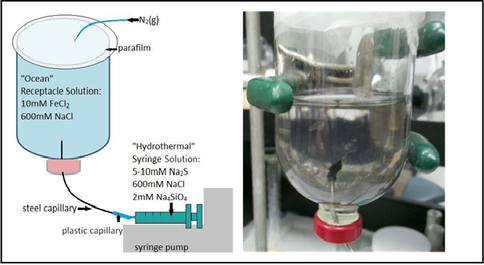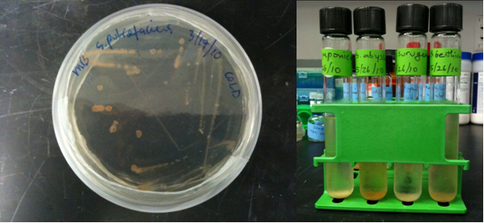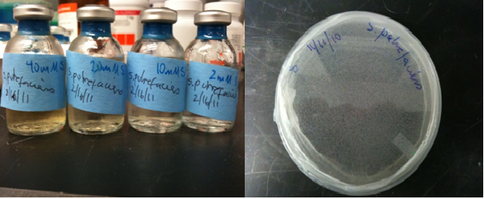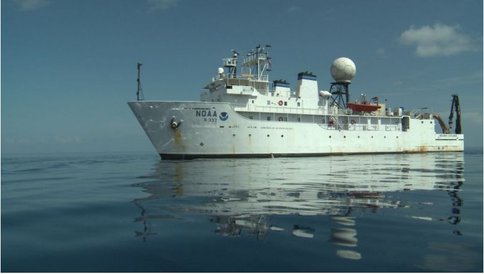2011 Annual Science Report
 NASA Jet Propulsion Laboratory - Icy Worlds
Reporting | SEP 2010 – AUG 2011
NASA Jet Propulsion Laboratory - Icy Worlds
Reporting | SEP 2010 – AUG 2011
Habitability of Icy Worlds
Project Summary
Habitability of Icy Worlds investigates the habitability of liquid water environments in icy worlds, with a focus on what processes may give rise to life, what processes may sustain life, and what processes may deliver that life to the surface. Habitability of Icy Worlds investigation has three major objectives. Objective 1, Seafloor Processes, explores conditions that might be conducive to originating and supporting life in icy world interiors. Objective 2, Ocean Processes, investigates the formation of prebiotic cell membranes under simulated deep-ocean conditions, and Objective 3, Ice Shell Processes, investigates astrobiological aspects of ice shell evolution.
Project Progress
Objective 1: Seafloor Processes
This objective investigates conditions that might be conducive to originating and supporting life in icy world interiors. To enable prediction testing by this and other teams pursuing related questions, we will define biomarker production and look for ground-truth in analog terrestrial systems.
Project 1: Hydrothermal reactor experiments for origin of life Investigators
Research: Tests the hypothesis that life can originate through a seafloor process that occurs at temperatures lower than those occurring in hydrothermal systems at mid-ocean ridges.
Year 3 Objectives: Investigating the formation of iron sulfide membranes; synthesizing of methane and formate in the hydrothermal reactor; demonstrating a series of geochemical and electrochemical reactions at submarine alkaline vents which lead inevitably toward metabolism as applied to Icy Worlds.
Progress: JPL hydrothermal reactor facility was reconstructed to withstand 400 bar pressures of hydrogen.
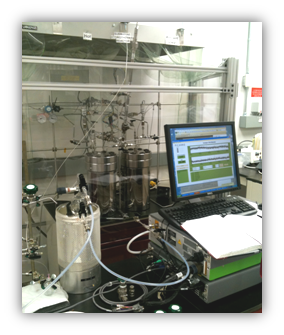
Figure 1-1. Photo of rebuilt hydrothermal reactor and on-line methane analyzer is shown.
Once rebuilt and tested, the first experiment involved the interaction of carbonic and ammoniacal fluids with ultramafic silicate rock and sulfide such as would be found comprising the crust of our own and other wet (icy) rocky worlds. This experiment produced formate and amino acids, in particular alanine>>glycine>>serine and epsilon amino-n-caproic acid. Peptides and various amines are also recorded. None of the normal contaminants were seen The generation of peptides is particularly significant as we argue that these entities can react with inorganic clusters to produce the first active enzyme-like catalysts (Milner-White and Russell, 2011).
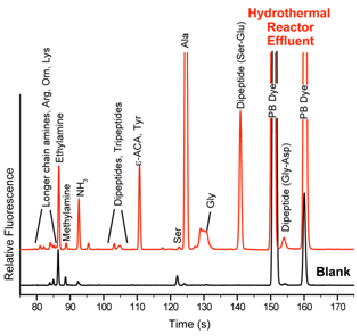
Figure 1-2. Organic product from the Hydrothermal Vent Reactor measured by Microchip Capillary Electrophoresis. Analysis as conducted by Amanda Stockton, JPL postdoc. Amino acids: alanine (Ala) > -ACA (amino-n-caproic acid) > glycine (Gly) > serine (Ser) and peptides. Acetate was not found.
A simulant of the reactor effluent was passed into the second reactor to produce the analog of the hydrothermal chimneys assumed to constitute the hatchery of life (Mielke et al. 1011; McGlynn et al., 2011). These chimneys are made the more durable by the addition of such peptides generated in the hydrothermal reactor and RNA. Their fine structure revealed a compendium of microcompartments comprising the inorganic membrane, ideal for the exploitation of redox and pH gradients acting across the membrane, for organic synthesis in a low entropy domain and the retention of product.
Figure 1-3. The experimental apparatus (left) used for the production of metal bearing chimneys (right) [Mielke et al. 2011 in press]. Operation temperatures STP and 70C.
Raman analyses of the hydrothermal chimneys so generated reveal that they are comprised of mackinawite (FeS) and, at higher temperature (70°C), greigite (Fe3S4) (Mielke et al., 2011). Greigite has a structure remarkably similar to active centers of both carbon monoxide dehydrogenase (CODH) and acetyl coenzyme-A synthase (ACS) while mackinawite has the same rhombic structure as hydrogenase. Hydrogenase, CODH and ACS are required enzymes in the microbiological synthesis of acetate—a process engineered by the homoacetogens. These so-called acetogenic bacteria employ the simplest and energetically cheapest of all the metabolic pathways. Thus this, the first generation of griegite in a simulated hydrothermal chimney, supports the view that such chimneys would have hosted “readymade” iron-sulfur clusters with affinities to those comprising the active sites of contemporary enzymes. Indeed, biology may have co-opted such a pre-existing functionality through the process of geo-mimicry.
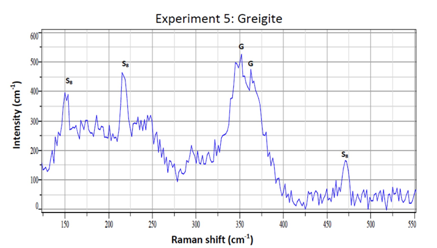
Figure 1-4. Raman spectrographic analysis shows evidence for greigite (Fe3S4) and some native sulfur in an iron sulfide chimney grown at 70C (Mielke et al., 2011, in press)
Knowing the nature of these chimneys, our next objective was to demonstrate the generation of pyrophosphate from monophosphate through the action of the proton gradient across these inorganic membranes as analyzed by nuclear magnetic resonance (NMR). This was achieved, though at rather low yields.
Figure 1-5. Condensation of pyrophosphate from acetyl phoshate and monophospate as influenced by the ambient proton motive force (vertical axis = %PPi increase) (Barge, White, Doloboff, Kanik and Russell, 2011).
While our attempts to condense amino acids by interaction with the pyrophosphate to peptides in the membrane are ongoing we did produce peptides within the hydrothermal reactor (see Figure 1-2). These results are particularly significant in that they feed into our hypothesis that sees the short peptides as the first emergent step to a functional organic world from inorganic beginnings (Milner-White and Russell, 2011). This paper sets the scene for further experimentation.
The results are consistent with our previously expressed view that the emergence of life on icy planets and moons was as inevitable as the onset of hydrothermal convection within their crusts-indeed, that a subaqueous convective system would have led directly to life’s emergence. The results also support similar arguments for the icy worlds elsewhere in the Universe. A certain logic is thus made plain that from the Big Bang onwards a cascade of linked entropy generators emerged in series, coupled one to another. They became ever smaller in their effective entropy generation while becoming ever more complex in their mechanisms: life achieving both reproduction of structure and replication with modification in a process whereby evolution acts as the search engine for the energies and materials required of colonization and procreation. Thus, life is likely to be as common in the Universe as hydrothermal convection cells operating within the crusts of rocky planets that have inventories of the trans-iron D-block elements and a holding of CO2 as substrate and electron acceptor.
Project 2: Life outside the Habitability Zone Box
Research: To test the hypothesis that a deep, cold, ocean can sustain life and to test the extent to which terrestrial life can adapt to such conditions, we culture facultative and obligate anaerobic microbes under simulated icy world conditions. This work assumes that an icy world ocean contains small amounts of organic compounds formed near regions of hydrothermal activity, abiotically as above, or as a byproduct of a long-lived – albeit low-productivity- ecosystem.
Year 3 Objectives:
- Culture microorganisms under icy world conditions of T, P, and composition. Investigate Fe, S, and C biogeochemical cycles mediated by microorganisms. Study change in gene expression under icy world conditions Interface with other investigators regarding biosignatures produced in lab work
- Investigate Fe, S, and C biogeochemical cycles mediated by microorganisms Formulate growth media
- Study change in gene expression under icy world conditions
- Interface with other investigators regarding biosignatures produced in lab work
Progress: Damhnait Gleeson joined the project as a postdoc in February of 2010 to carry out engineering tasks under the supervision of Xenia Amashukeli and to take responsibility for the cultivation work. Second year support was used to modify the pressure setup to allow cultivation of organisms under multiple sets of nutrient conditions, in addition to facilitating comparison of abiotic and biologically mediated reactions. This was achieved by sourcing and assembling multiple high-pressure cells in parallel. Testing of the modified system is continues as of this writing.
Cultivation temperature experiments investigated growth of bacterial strains as a function of temperature using a nutrient-rich “marine” media (Figure 2). The experiments were carried out in liquid media and on agar plates. Results showed that three strains – Shewanella japonica, algae and oneidensis – grew preferentially at room temperature (~25°C). Shewanella abyssi, benthica, surugensis and Moritella japonica grew preferentially at low temperature (~4°C). The final strain tested, Shewanella putrefaciens, grew successfully across both temperature ranges. This strain was prioritized for further experiments.
Minimal-media experiments evaluated whether strains would grow using a medium tailored for extremophiles from low nutrient environments (Figure 1-6). Vitamins and trace elements were added to minimal media. Carbon was provided in the form of acetate. This media was used to make agar plates, onto which colonies from previous experiments were streaked. Several strains showed limited growth and were prioritized for further experiments.
Figure 1-6. Initial determination of whether bacterial strains were mesophilic, psychrophilic or psychrotolerant.
Sulfur reduction experiments were initiated on both agar plates and in anoxic vials using a range of sulfur concentrations, for the purpose of evaluating whether strains would grow using colloidal sulfur as an energy source (Figure 1-7). Agar plates were streaked from colonies on marine agar plates while inoculants for liquid cultures came from fresh cultures grown up in marine broth. These experiments are ongoing.
Figure 1-7. Agar plates containing suspended colloidal sulfur and anoxic vials containing a range of sulfur concentrations.
Co-I Max Coleman and his collaborators continued their work in Investigation 1, Seafloor Processes by carrying out synthesis of abiotic organic matter through involvement in an exploration cruise to the area in which we discovered very deep high temperature hydrothermal vents in 2009. The cruise occurred in August 2011 and therefore this is a preliminary report. For this expedition the focus was the Von Damm low temperature diffuse venting system. The NOAA ship, Okeanos Explorer, is equipped with an ROV for HD video and imaging. We were part of a much larger science team involved via telepresence (using high speed internet) to the ship’s ROV operations in real time.
Figure 1-8. The NOAA ship (Okeanos Explorer) is equipped for ocean exploration and via its satellite link allows a real-time, wider scientific participation in the work than just the on-board team.
The results of this work will indicate the tectonic structure and context of the multiple hydrothermal vent fields. The Von Damm field was of particular interest, where we were able to observe a considerable and diverse fauna. The plume chemistry, sampled by CTD, suggests an ultramafic host rock but the ROV is also observed, presumably basaltic, pillow lavas. A really diverse fauna could be observed including both more than one species of shrimp and hydrothermal tubeworms. This is a surprising discovery in two ways: shrimp and tubeworms together at a vent site and the presence of tubeworms in the Atlantic province.
Figure 1-9. A tube worm is shown. Both hydrothermal tube worms and chemosynthetic shrimp co-exist at the Von Damm hydrothermal vent field. (Image courtesy of NOAA Ocean Explorer: Okeanos Explorer: Mid-Cayman Rise Expedition 2011.)
Our contribution was work on the plume chemistry from the CTD data as it was produced and the most important result was to show that the Von Damm site is distinct from the Europa vent field that we identified from plume chemistry in 2009. Although the marine fauna are of great interest biologically, the significance for our objective is that they are supported by the chemical energy of the vent fluids. As well the chemosynthetic microbes at the base of the food chain, our interest is to track the abiotic organic matter and to ascertain its contribution to the system. This work will be of great value when we return to observe and to sample with the research cruise planned for January 2012.
Objective 2: Ocean Processes
Investigates the formation of prebiotic cell membranes under simulated deep-ocean conditions, computationally assesses the distribution of material and heat through the ocean and ice shell, and seeks to improve relevant chemical literature through a set of high-pressure equation-of-state experiments.
- Set up fluorescence equipment / acquire calibration data Study the range of pH (if any) of bilayer vesicle formation in the presence of salts
- Analyze and publish results, interface with computational tasks
Progress: William Abbey and summer student Oamawa shields built on work by 2009 and 2010 Summer students, Shelley Shaul and Roshan Nanu, conducting studies of fatty acid vesicle formation using the astrobiology lab’s Hitachi scanning fluorescence spectrometer. They obtained evidence for a shift in the pH threshold for vesicle formation with temperature, independent from the concurrent shift in neutral pH.
- Project 2: Mass and Heat Transport in Icy World Oceans
Investigators: Steve Vance (Co-I, lead), J. Michael Brown, Jason Goodman (Co-I) Members: Geoffrey Collins
Research: Investigate the effects of salinity and turbulence on material and heat transport processes in icy world oceans, with implications for sustaining habitable “niches”.
Year 3 Objectives
- Evaluate role of turbulence in plume dynamics
- Evaluate role of precipitation in plume dynamics
- Evaluate pressure and composition dependent melting effects on ice ceiling
Evaluate pressure and composition dependent melting effects on ice ceiling
Progress: Dr. Goodman and his students used the supercomputer system at Wheaton College to run three-dimensional plume dynamics models comparing the size, velocity, and temperature of plumes, incorporating equations of state for MgSO4 and water that take into account pressure-dependence of thermal expansion and heat capacity, properties held constant in conventional dynamics models for Earth’s oceans. Goodman also developed a single-column convection model, which will allow exploration the overall vertical structure of Europa’s ocean on a global scale. Drs. Brown and Vance provided optimized equations-of-state based on recent analysis of their experimental data for aqueous MgSO4.
2008 Roadmap Objectives: This work addresses objectives 2.2, Outer Solar System exploration; and 4.3, Effects of extraterrestrial events upon the biosphere.
- Project 3: Icy World Ocean Chemistry
Figure 1-10. Single-column convection model (on the left) used to investigate vertical density structure of Europa’s ocean. Convective mixing is modeled as a vertical diffusive processs. Model includes heat and salt fluxes at top and bottom of ocean, full equation-of-state information for MgSO4 brines, and a parameterization for double-diffusive effects. Accounting for MgSO4 P-dependent thermal expansion, as in the 0.3 molal ocean on the right, plume rise is less turbulent (and more efficient at transport) due to less expansion of the plume while rising (d2Vsp/dPdT matters).
Research: Investigate the effects of low temperature and high pressure on the chemistry of icy world ocean solutions.
Year 3 Objectives:
- Obtain equations of state for aqueous ammonia under deep ocean pressures and temperatures.
- Incorporate existing and new data into chemical models such as FREZCHEM.
Progress: Professor Brown and Dr. Vance conducted a focused set of sound velocity measurements in aqueous ammonia (a proxy for Titan’s ocean). Comparing new results with previous equations of state for solution density (Croft et al. 1988), they find that these previous results do not produce self-consistent forward-modeling results for sound velocity. Moreover, the new results reveal that sound velocities in aqueous ammonia show less concentration dependence than previously expected. Corresponding specific volumes (densities) are universally lower than previously predicted, strengthening arguments against extrusive ammonia-water cryo-volcanism on Titan.
Further analysis of MGSO4 data led to new computational techniques for fitting three-dimensional (P,T,m) sound velocity data and producing smooth inversions for density and other thermodynamic properties. These equation-of-state data are being incorporated into work by Goodman and other Icy Worlds investigators at Wheaton college.
Objective 3: Ice Shell Processes
Investigates astrobiological aspects of ice shell evolution. Experimental work examines the creation of clathrate hydrates. Computational modeling of ice shell convection tracks the shuttling of these and other biorelevant materials between oceans and surfaces, and also examines the possibility of “sub-glacial” lakes as briny oases within the ice.
- Project 1: Clathrate Formation, Stability and Dynamics Investigators: Mathieu Choukroun (Co-I, lead), Christophe Sotin (Co-I) and Olivier Grasset (Co-I)
Research: Investigate the stability of clathrate hydrate compounds under icy satellite conditions, thus providing information on their ability to store and bring material—possibly of biological origin—to the surface of icy satellites.
Year 3 Objectives:
- Investigate the stability of clathrates under icy world pressures and temperatures.
- Develop multi-phase ice-shell model to assess liquids’s role in ice shell habitiability/transport
- Analyze and publish results, interface with computational/experimental task
Progress: Experiments conducted in the H2O-CO2 system have shown a phase transition to a high-pressure phase of CO2 clathrate hydrates around 800 MPa. The structure of this phase, as could be seen optically and in the Raman spectral signature, presents strong similarities with the well-constrained high-pressure hexagonal phase of methane clathrate hydrates. This phase consistently transformed into ice VI and solid CO2 around 1200-1300 MPa, transition pressure that did not seem temperature-dependent over the range explored in the experiments. The reason for this dissociation under pressure remains to be explored.
The test, conducted on CO2 clathrates in a H2O-MgSO4 solution, provided inconclusive results, primarily because the MgSO4 concentration was very low (<2%). Further tests are required to investigate further the influence of MgSO4 on the stability of clathrate hydrates at icy worlds conditions.
- Project 2: Convection in Icy Lithospheres – simulating mass transport
Research: Trace mass transport in simulations of convecting in ice shells in order to address the transport of ocean materials, such as clathrate hydrates, salts, and biomolecules, from the interior to the surfaces of icy satellites.
Year 3 Objectives: Trace mass transport in computational models of convecting ice shells.
Progress: During Year 3, we have conducted numerical simulations in 3D spherical coordinates and 3D Cartesian coordinates (thin shell) which allows us to run simulations on a (256×256×256) grid. We were interested in the scaling of the vertical velocity for realistic values of the viscosity. One key parameter which controls the stability of the thermal boundary layer is the activation energy. But the larger the activation energy is, the more challenging the numerical simulation. During Year 3, we have run 10 simulations with two different values of the viscosity at melting temperature (1013 and 1014 Pa) and 5 different values of the activation energy. The results are being processed. The velocities will allow us to address the question of how much time it takes for the particles embeded into the freezing ice at the base of the ice crust to reach the base of the conductive lid.
A second aspect of our numerical simulations is to investigate the horizontal stress applied by the convection process at the base of the conductive lid and to compare it with the yield stress necessary to break the ice lid. We have calculated these values for each of the 10 numerical simulations and data are being processed.
- Project 3: Convection in Icy Lithospheres – multiphase model
Research: Develop a multi-phase ice shell model to assess role of liquids in ice shell habitability and transport.
Progress: We have been investigating places where ice can melt and determine the amount of partial melting using the (P,T,composition) equations determined in project 1 (Choukroun and Grasset, 2010). We adapted the multiphase code which looks at the differentiation of liquid iron within silicate mantle to the case of percolation of liquid water in a ice matrix.
Publications
-
Barge, L. M., Doloboff, I. J., White, L. M., Stucky, G. D., Russell, M. J., & Kanik, I. (2012). Characterization of Iron–Phosphate–Silicate Chemical Garden Structures. Langmuir, 28(8), 3714–3721. doi:10.1021/la203727g
-
Choukroun, M., & Grasset, O. (2010). Thermodynamic data and modeling of the water and ammonia-water phase diagrams up to 2.2 GPa for planetary geophysics. J. Chem. Phys., 133(14), 144502. doi:10.1063/1.3487520
-
Davies, A. G., Sotin, C., Matson, D. L., Castillo-Rogez, J., Johnson, T. V., Choukroun, M., & Baines, K. H. (2010). Atmospheric control of the cooling rate of impact melts and cryolavas on Titan’s surface. Icarus, 208(2), 887–895. doi:10.1016/j.icarus.2010.02.025
-
Fortes, A. D., & Choukroun, M. (2010). Phase Behaviour of Ices and Hydrates. Space Sci Rev, 153(1-4), 185–218. doi:10.1007/s11214-010-9633-3
-
Lorenz, R., & Sotin, C. (2010). The Moon That Would Be a Planet. Scientific American, 302(3), 36–43. doi:10.1038/scientificamerican0310-36
-
McGlynn, S. E., Kanik, I., & Russell, M. J. (2012). Peptide and RNA contributions to iron-sulphur chemical gardens as life’s first inorganic compartments, catalysts, capacitors and condensers. Philosophical Transactions of the Royal Society A: Mathematical, Physical and Engineering Sciences, 370(1969), 3007–3022. doi:10.1098/rsta.2011.0211
-
Mielke, R. E., Robinson, K. J., White, L. M., McGlynn, S. E., McEachern, K., Bhartia, R., … Russell, M. J. (2011). Iron-Sulfide-Bearing Chimneys as Potential Catalytic Energy Traps at Life’s Emergence. Astrobiology, 11(10), 933–950. doi:10.1089/ast.2011.0667
-
Nitschke, W., & Russell, M. J. (2011). Redox bifurcations: Mechanisms and importance to life now, and at its origin. BioEssays, 34(2), 106–109. doi:10.1002/bies.201100134
-
Robuchon, G., Choblet, G., Tobie, G., Čadek, O., Sotin, C., & Grasset, O. (2010). Coupling of thermal evolution and despinning of early Iapetus. Icarus, 207(2), 959–971. doi:10.1016/j.icarus.2009.12.002
-
Simoncini, E., Russell, M. J., & Kleidon, A. (2011). Modeling Free Energy Availability from Hadean Hydrothermal Systems to the First Metabolism. Orig Life Evol Biosph, 41(6), 529–532. doi:10.1007/s11084-011-9251-4
-
Sohl, F., Choukroun, M., Kargel, J., Kimura, J., Pappalardo, R., Vance, S., & Zolotov, M. (2010). Subsurface Water Oceans on Icy Satellites: Chemical Composition and Exchange Processes. Space Sci Rev, 153(1-4), 485–510. doi:10.1007/s11214-010-9646-y
-
Wolfe-Simon, F., Blum, J. S., Kulp, T. R., Gordon, G. W., Hoeft, S. E., Pett-Ridge, J., … Oremland, R. S. (2010). A Bacterium That Can Grow by Using Arsenic Instead of Phosphorus. Science, 332(6034), 1163–1166. doi:10.1126/science.1197258
- Choukroun, M., Kieffer, S.W. & Lu X., T.G. (In Press). Clathrate hydrates: Implications for Exchange Processes in the outer Solar System [Book Chapter]. Solar System Ices.
- Gleeson, D.F., Amashukeli, X. & Pappalardo, R.T. An investigation into biologically mediated sulfur cycling under simulated Europa ocean conditions.
- Hussmann, H., Choblet, G., Lainey, V., Matson, D., Sotin, C., Tobie & Van Hoolst, T. (2010). Internal Processes: Energy Sources and Heat Transport in Icy Satellites. In: Grasset et al. (Eds.). Internal Processes: Energy Sources and Heat Transport in Icy Satellites.
- Milner-White, E.J. & Russell, M.J. (2011). , A peptide era heralding the emergence of life. Genes, 2: 671-688.
- Russell, M.J. (2011). Origins, Abiogenesis and the search for Life. Cambridge: Cosmology Science.
- Russell, M.J. (2011). The origin of life. Encyclopaedia of Geobiology. Netherlands: Reitner, J and Thiel, V. Singer.
- Schoepp-Cothenet, B., v.L., R., P., P., M., A., R-W. & Russell, M.J. (2011). A peptide era heralding the emergence of life. Genes, 2: 671-688.
- Schubert, G., Hussmann, H., Lainey, V., Matson, D., McKinnon, W., Sohl, F., Sotin, C., Tobie, G., Turrini, D. & Van Hoolst, T. Evolution of the Moons; Europlanet. Icy Satellites.
-
PROJECT INVESTIGATORS:
-
PROJECT MEMBERS:
Evan Abramson
Collaborator
John Baross
Collaborator
Lance Christensen
Collaborator
David Deamer
Collaborator
Richard Kidd
Collaborator
Robert Pappalardo
Collaborator
Mathieu Choukroun
Postdoc
Damhnait Gleeson
Postdoc
William Abbey
Research Staff
Randall Mielke
Research Staff
Lauren Spencer-White
Graduate Student
Roshan Nanu
Undergraduate Student
Laura Barge
Unspecified Role
-
RELATED OBJECTIVES:
Objective 1.1
Formation and evolution of habitable planets.
Objective 2.1
Mars exploration.
Objective 2.2
Outer Solar System exploration
Objective 3.1
Sources of prebiotic materials and catalysts
Objective 3.2
Origins and evolution of functional biomolecules
Objective 3.3
Origins of energy transduction
Objective 3.4
Origins of cellularity and protobiological systems
Objective 4.1
Earth's early biosphere.
Objective 5.1
Environment-dependent, molecular evolution in microorganisms
Objective 5.3
Biochemical adaptation to extreme environments
Objective 6.1
Effects of environmental changes on microbial ecosystems
Objective 6.2
Adaptation and evolution of life beyond Earth
Objective 7.1
Biosignatures to be sought in Solar System materials
Objective 7.2
Biosignatures to be sought in nearby planetary systems
